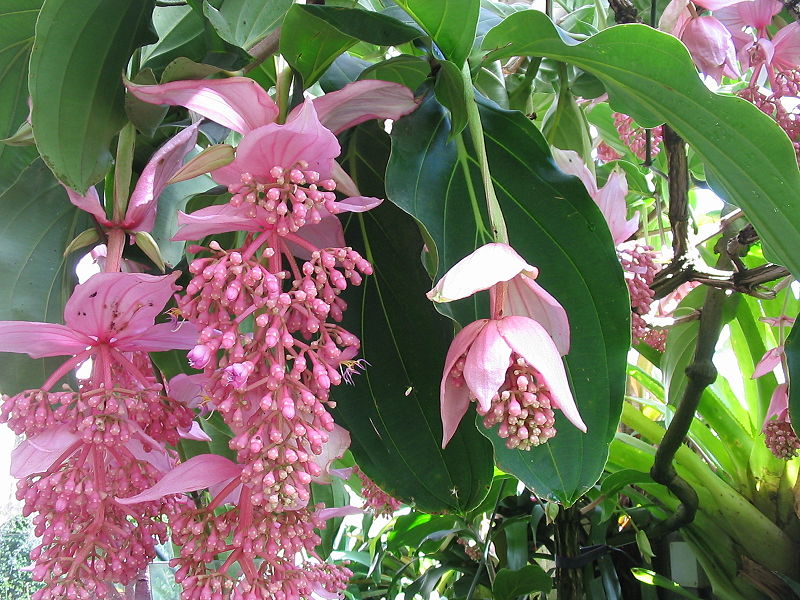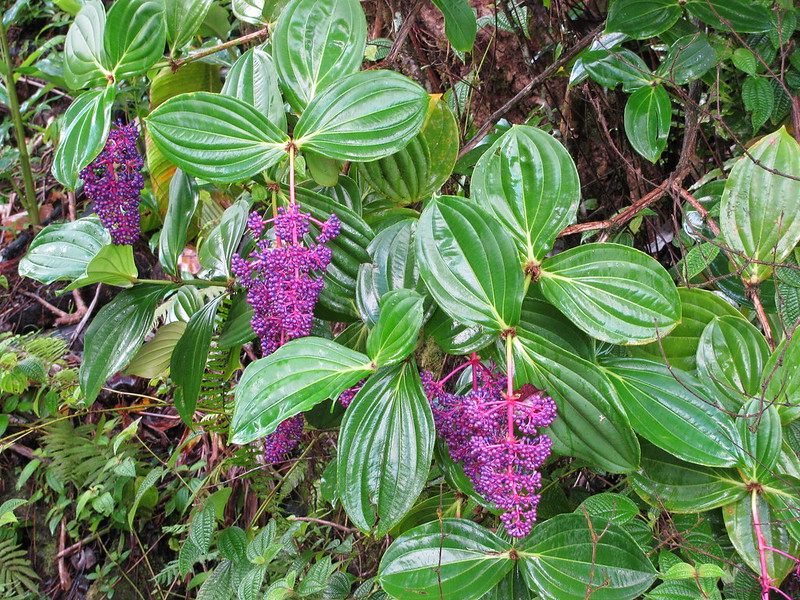Betrayed by beauty – Invasive Medinilla:
Medinilla magnifica and Medinilla cumminigii are invasive species in Hawaii. Yet, some garden stores continue to promote and sell them as prized horticultural specimens. Profusely blooming and fruiting, the plant blooms with showy pink or purple flowers that hang pendant. Numerous bright berries full of viable seeds are ever-present in large bunches. No one can deny they are beautiful, but is the ecological cost worth it?
Medinilla is revered in its native home range in the Philippines, where it belongs (right plant, right place!) But it does not belong in Hawaii’s rainforests, where it steals resources from native plants and thus deprives our native insects and birds of their co-evolved habitats. The large leathery leaves are oppositely arranged, exhibiting the Melastome family’s tell-tale signs: prominent longitudinal veins running along the leaf edge. Like its highly invasive cousins miconia, tibouchina, and clidemia (Koster’s curse), medinilla moves into intact forests, growing easily in shady areas and on many substrates. Medinilla even has a secret weapon: it can grow epiphytically, sprouting high in the branches of mature trees or from clumps of moss on a trunk.

Yet even as the invasion grows and expands into new territory, medinilla continues to be sold and cultivated in Hawaii. Plant lovers and home gardeners, unaware of the plant’s threat to our island ecosystem, cultivate medinilla purchased at their local garden store – never realizing that it is still legal in Hawaii to sell invasive plants!
While there are strict rules around importing and raising many animal species, Hawaii lacks laws to regulate invasive plants’ sales and cultivation. Members of the medinilla genus are considered one of Hawaiis’ Most invasive horticultural plants‘ by our State Department of Land and Natural Resources (DLNR). Still, nothing prevents a retailer from selling other invasive medinilla species.
Plant Pono endorsed nurseries do not sell Medinilla or other invasive plants. In 2016, Walmart agreed to discontinue the sale of medinilla as well.
What makes Medinilla invasive?
Both species thrive and ‘move around’ without human intervention. Hawaii island, Maui, and Oahu have all reported escaped populations. Both Medinilla species are capable of producing 100,000 seeds per flowering event. There are hundreds of berries on a singular plant, and dozens of seeds are contained within each small berry. Attracted to the bright colors, birds eat the fruit and distribute the seeds, sometimes miles away from the parent plant. Because Medinilla is epiphytic, it readily grows wherever birds perch – high up in trees, on utility poles, or atop fence posts. Medinilla thrives in low light conditions, meaning it can flourish in a closed canopy forest.

Prolific seed production + shade tolerance + bird dispersal = trouble for native ecosystems
The invasion is getting worse as more people cultivate the plant, bringing it into new areas. More residents growing medinilla means more opportunities for birds to eat and spread the seeds and add to the number of thriving naturalized populations that constantly produce viable seeds.
Battling Medinilla: One Nursery’s Tale

Floribunda Palms and Exotics, a Plant Pono-endorsed business, sells rare noninvasive palm species. Owners Jeff and Su Marcus have traveled the tropical world, searching for unique palm species to bring into cultivation. Some of the rainforests Jeff and Su explored are gone forever. With a sense of urgency, they have hiked through tropical jungles, knee-deep in mud, with air so humid it was impossible to sweat and mosquitoes, so numerous it was impossible to hear. In Malaysia, home to orangutans, vibrant wildlife, and rare plants, more than 40,000 acres of rainforest were destroyed for palm oil agriculture. Jeff and Su rescued many palm species before the slash and burn style farming wiped out the diverse landscape.
They follow all harvesting and importation laws, even vetting new species for invasiveness before bringing the propagules into the horticulture trade. Their work is a labor of love. The export/import paperwork from the host country to Hawaii is enough to dissuade most people, but the Marcus family doesn’t scare easily. The result of their heart-felt work is a living botanical museum, right on the east side of Hawaii Island. Floribunda Palms and Exotics is world-renowned; Google and Facebook are among their famous customers. Nowhere else on earth can one find this many palm species in one place.

With all the hard work and love Jeff and Su put into their life’s calling, there is one thing they have no control over – invasive plants. Near their carefully curated property, a neighbor grows a massive hedge of Medinilla. Birds attracted to the bright berries, eat the seeds, and fly away to rest atop the rare palm species. It’s a perfect storm – tall trees, abundant bird-dispersed seeds, epiphytic growth, and the right climate. Medinilla growing in the palm’s crown is a direct threat to that tree’s flowering and seed production.
After many precarious ladder climbs, the Marcus’ have approached their neighbors about removing the medinilla in favor of more neighbor-friendly alternatives. However, because Hawaii has no laws preventing the sale, propagation, and cultivation of invasive plants, their request is only that – a request, which has been declined. They have no legal route to pursue as Hawaii has no regulations about growing most invasive plants – and so, back up the ladder they go, pulling the noxious melastome from their rare and precious palms.

Invasive plants might not seem like a problem in our individual small landscapes. When we broaden our view, we can see how invasive plants are biological pollution for others. Growing Medinilla is like throwing trash in a river. Upstream the water is clean and clear. It’s downstream where the trash piles up. What we grow in our yards has an effect on those around us and in the native forest.
Planting pono means more than protecting the aina from invasive plants; it also means being a good neighbor.






